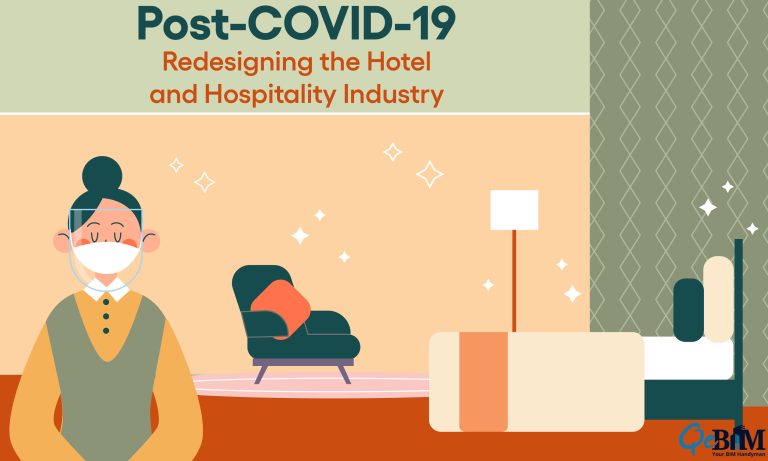Post-COVID-19: Redesigning the Hotel and Hospitality Industry

Prolonged lockdown situations, working consistently from home, and staying away from the natives, friend, and neighborhood for an extended time has increased the frustration level among the people. The immaculate, minimalistic resorts where people used to have leisure time have become the dream destinations for some fronting from the chaos of the pandemic. But the fear among them of staying just anywhere and getting caught in their worst nightmare of COVID keeps them resistant towards traveling places even post-pandemic. While people are still wondering how they will travel worldwide, the hospitality industry is at the stake of losing everything and shutting down.
Well, most of us know that the hotel or the hospitality industry is witnessing the unprecedented damages of the pandemic globally; their owners, operators, and designers should reconsider every aspect of guest experience clubbing with the safety norms of a pandemic.
For sure, the pandemic will pass eventually, but the hotel industry will need to redesign and reinvent their spaces to meet the changed demand post-COVID. The architect’s imagination and the traveler’s experience should be synced well, keeping the new force of safety, well-being, and social distancing in mind. Architectural BIM Services will help the architects and designers to interconnect the design strategies with the current situations and existing architecture.
Below are the potential hotel redesigning strategies or solutions that will fundamentally change the hotel design in the long run and can embrace the hospitality experience.
Hotel Design Strategies to Incorporate/ Consider Post COVID
1) Cleanliness & Sanitization
Cleanliness tops the chart of every hotel’s agenda in the future. Since this contagious disease spreads horribly with just contact, cleanliness and sanitization are paramount. To incorporate a high level of safety in terms of hygiene, there must be profound design changes as below in introducing the technology.
- Sensor-based Operations: High contacts and touch areas like door handles, elevator buttons, and light switches will be replaced by touch-free interactions, keyless & contactless systems such as facial recognition, automatic doors and elevators, sensor-controlled switches, gesture-operated equipment, and voice-activated equipment.
- Digital Apps: High contact areas, such as room collaterals like the food menu, safety guide, etc., should be replaced by an online menu and digital instruction.
- Electrostatic Cleaning Regime: Common areas such as Hallways, Cafeterias, Restaurants, Ballrooms, Gyms, etc., shall be cleaned and sanitized with cleaning regimes that are timer based.
- Sanitization Stations: Automatic sanitization stations should be kept at multiple places in the hotel area for children and individuals.
2) Architectural & Design Alterations
The guidelines for social distancing in public areas will lead to a massive change in the architecture and design modification for
- Room Designs: Biophilic designs are the driver of the new room designs with spread balconies, patios, and functional windows that allow fresh air in.
- Hotel Entrance/Exit: Since this involves much of foot-traffic, the entrance and exit passage should be separated to reduce the flow.
- The Hallways/ Lobbies: Since this is common for all and might involve many people at a time, the hallways should be elongated to let people follow the rules of minimum distancing.
- Conference Rooms: There should be advanced booking for such standard rooms, and they should be designed spaciously to allow personal seating arrangements with minimal requisite gaps.
- Connected Outdoor Spaces: Things like a shared balcony, outdoor spaces, or bath areas should be redesigned as specific to the rooms.
- Gardens: The gardens should also be spacious, and the amenities kept there for seating should be at a minimal distance. The areas and attractions where people can gather, like fountains, should be avoided for the time being.
- Cafeteria and Restaurants: These should be designed carefully with ample seating to accommodate maximum pax at a time with following social norms.
3) Material & Equipment Modifications
- Lighting Systems: An exciting innovation in lighting design, as implemented by Marriott, was the introduction of ultraviolet light technology.
- Materials and Furniture: Since cleanliness will be the core aspect, all the furniture and materials shall be durable and able to withstand the cleaning and sanitizing spirits. All the bedding, carpeting, mattresses, bathroom wear, etc., should be antibacterial and cleaned after each use.
- Pandemic-Ready HVAC Systems: Since this is an airborne disease, and the existing HVAC systems can accelerate the transmission of the same, pandemic-ready HVAC systems should be introduced to minimize the spread of the virus by regulating the room pressure levels.
- Robotic Servers: Instead of physical servers, introduce robots for numerous facilities such as serving food, taking orders, cleaning facilities, etc.
Redesigning the Hotel with The New Normal of Post-Pandemic
The hotel industry is a big hit by COVID-19. Re-shaping the same with new norms and guidelines will be fruitful for both the owners and the travelers. Incorporating the above design strategies, will no doubt cost you a bit. However, it will surely reap considerable benefits if you still need clarification about what will fit your hospitality environment and what not, consider iterating possibilities with BIM Modelling Services to get clarity on the changes and their repercussions.